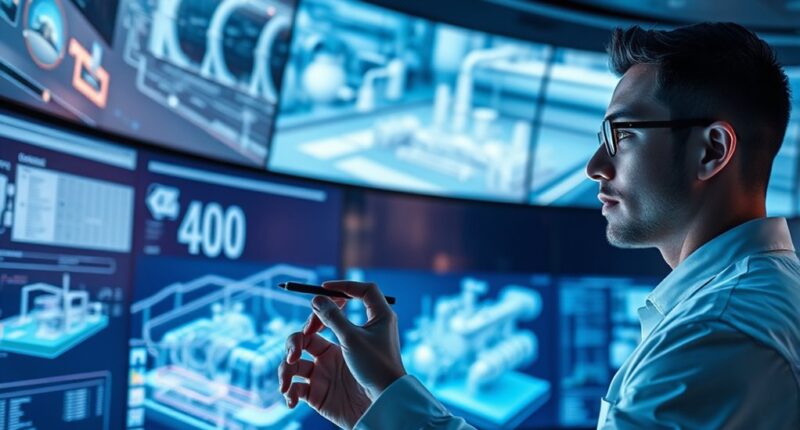Creating digital twins for operational planning involves gathering extensive sensor and environmental data to build a detailed virtual model of your system. You then run real-time simulations to test different scenarios, predict outcomes, and optimize processes without risking actual resources. This approach helps you anticipate issues, improve efficiency, and make smarter decisions proactively. By integrating ongoing data updates, your digital twin stays current, enabling continuous improvements—if you explore further, you’ll discover even more valuable insights.
Key Takeaways
- Collect comprehensive sensor and environmental data to establish an accurate virtual model of the physical system.
- Develop a detailed digital twin that reflects system structure, behavior, and real-time operational data.
- Use simulation and scenario testing to evaluate operational changes and optimize decision-making.
- Continuously synchronize the digital twin with the physical system for real-time updates and predictive maintenance.
- Leverage analytics within the digital twin to enhance efficiency, reduce downtime, and support proactive planning.

Digital twins are transforming planning processes by providing a dynamic, real-time simulation of physical systems. With this technology, you can visualize how your operations function under various conditions without disrupting the actual environment. Instead of relying solely on static models or historical data, a digital twin offers a real-time simulation that updates continuously as conditions change. This immediate feedback allows you to see potential issues before they happen and make informed decisions quickly. By integrating data from sensors and IoT devices, your digital twin becomes a living replica of the physical system, enabling you to monitor performance with precision and responsiveness. Predictive analytics become a core component of this setup, helping you forecast future outcomes based on current trends and historical patterns. For example, if you’re managing a manufacturing process, your digital twin can analyze machine data to predict failures or maintenance needs before breakdowns occur. This proactive approach minimizes downtime and maximizes efficiency, giving you a competitive edge.
Creating a digital twin for operational planning involves several key steps. First, you need to gather extensive data from your physical systems, including sensor inputs, operational logs, and environmental conditions. This data forms the foundational layer of your digital twin. Next, you’ll develop a detailed virtual model that accurately reflects the physical system’s structure and behavior. This model should be capable of receiving real-time data feeds, ensuring that your simulation remains current and relevant. Once the digital twin is operational, you can run simulations to explore different scenarios, such as adjusting production schedules or testing new layouts. Here, real-time simulation plays a critical role, allowing you to see the immediate impact of changes without risking actual resources. You can also leverage predictive analytics to evaluate the potential outcomes of various decisions, helping you optimize processes and allocate resources more effectively. Additionally, understanding juice cleanses can be a metaphor for the importance of data purification and preparation in creating accurate digital twins, ensuring your models reflect true operational conditions.
Furthermore, creating a feedback loop between your digital twin and the physical system enhances continuous improvement. As real-world conditions evolve, your digital twin updates accordingly, providing ongoing insights. This ongoing synchronization allows you to anticipate problems, optimize workflows, and plan maintenance schedules proactively. Over time, the insights gathered from your digital twin can be used to refine your operations further, making your planning more accurate and responsive. In summary, digital twins empower you to move from reactive to proactive planning, reducing uncertainty and improving overall operational efficiency. By harnessing real-time simulation and predictive analytics, you create a smarter, more agile approach to managing complex systems and ensuring your organization stays ahead in a competitive landscape.
Frequently Asked Questions
How Do Digital Twins Adapt to Real-Time Operational Changes?
Digital twins adapt to real-time operational changes by continuously integrating real-time data, allowing them to reflect current conditions accurately. You can use adaptive modeling techniques that update the twin’s parameters dynamically as new data flows in. This real-time feedback loop helps you make informed decisions quickly, optimize processes, and respond swiftly to operational shifts, ensuring your digital twin remains an accurate, reliable representation of your physical system at all times.
What Are the Cybersecurity Risks of Implementing Digital Twins?
The ball’s in your court when it comes to cybersecurity risks with digital twins. You face vulnerabilities like hacking attempts, which could compromise sensitive data privacy, or malicious manipulation that disrupts operations. These cybersecurity vulnerabilities demand robust defenses, including encryption and access controls, because neglecting them is like leaving the back door open. Protecting your digital twin guarantees operational integrity and guards against potential cyber threats.
How Cost-Effective Are Digital Twins for Small Organizations?
Digital twins can be cost-effective for small organizations if you perform a thorough cost analysis upfront. They help optimize operations, reduce downtime, and improve decision-making, leading to a strong ROI. While initial setup costs may seem high, the long-term savings and efficiency gains often outweigh expenses. By carefully measuring ROI metrics, you can determine whether adopting digital twins will bring significant value to your organization without overextending your budget.
Can Digital Twins Integrate With Existing Enterprise Systems?
Yes, digital twins can integrate with your existing enterprise systems through system integration processes, ensuring seamless data exchange. They enable real-time data synchronization, which keeps the digital replica up-to-date with actual operations. You’ll benefit from smoother workflows, better decision-making, and enhanced operational visibility. Properly implemented, digital twins work alongside your current infrastructure, making integration straightforward and supporting your organization’s digital transformation goals effectively.
What Are the Limitations of Current Digital Twin Technologies?
You face digital twin limitations that feel like hitting a brick wall! Data accuracy can sometimes be so off that it’s like trying to hit a moving target blindfolded. Scalability challenges make expanding digital twins feel like trying to stretch a rubber band until it snaps. These issues hinder real-time insights and smooth integration, so you need innovative solutions to overcome these hurdles and release the full potential of digital twins in operational planning.
Conclusion
By embracing digital twins for planning, you open unmatched understanding and ultimate efficiency. With wise, well-woven virtual visuals, you’ll wield data-driven decisions and ward off waste. This powerful, predictive tool propels your planning process forward, fostering flexibility and foresight. So, step into the seamless sphere of digital twins, where innovation inspires insight, and your operational obstacles become opportunities. Trust technology’s transformative touch to turn today’s challenges into tomorrow’s triumphs.









